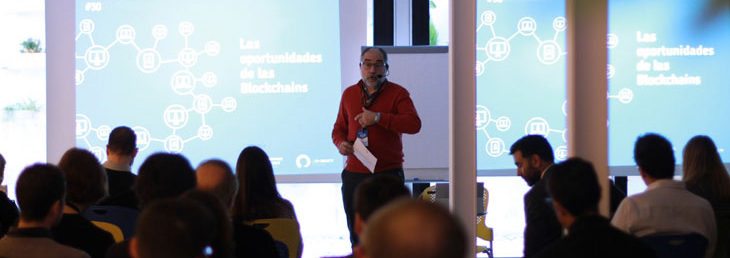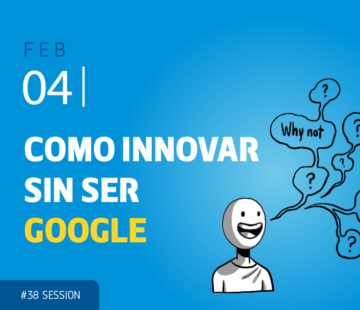#30 co-session (II): Blockchain, what’s in it for me?

Besides knowing about the most interesting projects based on Blockchain already in place or how this technology can change the way energy is distributed, our 30th Co-Session originated other interesting insights, as when we had the opportunity to learn how Blockchain really works or to discuss what’s in it for the company and industry of each of the attendees.
Understanding EthereumThe aim of the presentation from Adrià Massanet, a freelance developer specializing in security, cryptography, and Ethereum, was to go into more depth on the special characteristics of this platform and protocol that were originally conceived as an improved version of the blockchain that supports Bitcoin. Created with the initial purpose of decentralizing the web, Massanet said that Ethereum can be seen as a single secure global computer. This security becomes a key differentiator: while on the Internet that we know today secure transmission occurs between nodes and applications, in Ethereum this security is implicitly built into the system itself.
Blockchain is going to decentralize everything. Therefore, Massanet proposed a system to seek challenges and opportunities in our own sectors that stem from this new context. Firstly, we need to think about which intermediaries can disappear if a fully horizontal governance model is applied to known business models. Subsequently, we have to become a new player capable of providing new value in this new model of 100% horizontal governance.
Finally, we also heard about some of the most innovative projects based on this technology that are currently underway. They include Brave Payments, a cryptocurrency created to easily and automatically reward the creators of content consumed in the network, and Polkadot, a project that aspires to make it possible to connect different blockchains, creating what could be called an “Internet of blockchains”.
Witcoin: a cryptocurrency for knowledge exchange
Today, many of our assets have been digitized: our photographs, our medical records, our signature and even our identity. In addition, our money is already principally a posting line in digital format. Pep Lluís de la Rosa, a professor at the University of Girona and a specialist at Intelligent Agents, presented us with another of the many disruptive ideas that Blockchain can make possible: we can also digitize the value of our knowledge, converting it into a currency that allows us to openly reward its exchange.
As we all know, time is money. This is also the case with knowledge, although it is not always easy to convert it. Knowledge creates value, but most of the time there is no easy way to recognize this merit. Witcoin is mooted as a currency that can facilitate the transaction of knowledge without the need for the type of bureaucracy (patents, management of intellectual property, etc.) that is necessary nowadays to recognize the value contributed by the person who generates it. Using the Ethereum platform, Witcoin makes it possible to certify every instant of knowledge transaction, thereby transforming it into an asset. Its promoters intend to eliminate the fear of copying or the lack of recognition that precludes a greater flow and exchange of ideas, which are the driving force behind the generalization of the concept of Open Innovation and the basis of a true Knowledge Economy.
Hands-on workshop: How a blockchain works
Explaining exactly how Blockchain works is not a simple task. It was therefore a good idea to recreate how it functions by making some of the main processes of the system tangible and converting the Co-Society fellows into distributed nodes and ledgers. It was time to stop listening to presentations and get into “hands-on” mode in a workshop led by Co-Society collaborator Josep Lluís Sànchez. Participants physically represented the basic elements of a Blockchain environment (network, transaction, ledger, and block), as well as the rules and processes under which these elements relate to one another.
To do this, 10 groups were formed, each acting as a node involved in the process of a theoretical bitcoin transaction. Each group worked with two sheets of paper representing two blocks from the same ledger. A simple algorithm allowed the transactions to be signed digitally. Then it was time to transmit each transaction to the entire network, represented by the rest of the groups (nodes). Adhesive labels were used as the support for the digital signature of each transaction. The corresponding figure certifying the origin of the posting line was written on them before they were passed to the other tables where they were recorded and validated by participants in their own copies of the ledger.
What’s in it for me
Finally, after everything we had learned during the day, it was time to reconsider and debate what Blockchain can mean for each of our companies and sectors. This time for reflection was set out in terms of challenges and opportunities, with a questionnaire completed beforehand in which participants were required to answer three main questions about Blockchain: What could it help us achieve in relation to our business and processes, what would we be obliged to do if it became generalized, and finally, what do we need in our organizations to be able to use its capabilities and take advantage of them.
Certain consensus was reached in relation to the first question, focusing on the most likely potential benefits of Blockchain in reducing operational costs and automating certain processes, especially those related to transactions, certifications and asset management. Also apparent was the significant barrier to entry that existing systems of trust and traceability imposed by large companies on all their suppliers can represent to highly regulated sectors such as heavy industry or manufacturing. On the other hand, Blockchain will make it obligatory to generate talent resources that are specialized in this technology, which are still very scarce today. It will also force business or even social change that truly demands levels of transparency that it makes possible. In any event, in order to take advantage of Blockchain, companies will above all need expert advice, greater knowledge of the opportunities that it can generate for them and the necessary requirements for this to take place.
